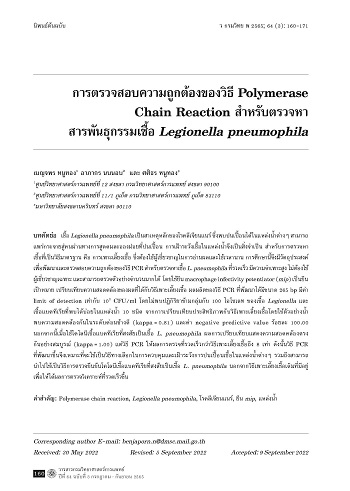การตรวจสอบความถูกต้องของวิธี Polymerase Chain Reaction สำหรับตรวจหาสารพันธุกรรมเชื้อ Legionella pneumophila
คำสำคัญ:
Polymerase chain reaction, Legionella pneumophila, โรคลีเจียนแนร์, ยีน mip, แหล่งน้ำบทคัดย่อ
เชื้อ Legionella pneumophila เป็นสาเหตุหลักของโรคลีเจียนแนร์ ซึ่งพบปนเปื้อนได้ในแหล่งน้ำต่างๆ สามารถแพร่กระจายสู่คนผ่านทางการสูดดมละอองฝอยที่ปนเปื้อน การเฝ้าระวังเชื้อในแหล่งน้ำจึงเป็นสิ่งจำเป็น สำหรับการตรวจหาเชื้อที่เป็นวิธีมาตรฐาน คือ การเพาะเลี้ยงเชื้อ ซึ่งต้องใช้ผู้เชี่ยวชาญในการอ่านผลและใช้เวลานาน การศึกษานี้จึงมีวัตถุประสงค์เพื่อพัฒนาและตรวจสอบความถูกต้องของวิธี PCR สำหรับตรวจหาเชื้อ L. pneumophila ที่รวดเร็ว มีความจำเพาะสูง ไม่ต้องใช้ผู้เชี่ยวชาญเฉพาะ และสามารถตรวจตัวอย่างจำนวนมากได้ โดยใช้ยีน macrophage infectivity potentiator (mip) เป็นยีนเป้าหมาย เปรียบเทียบความสอดคล้องของผลที่ได้กับวิธีเพาะเลี้ยงเชื้อ ผลผลิตของวิธี PCR ที่พัฒนาได้มีขนาด 265 bp มีค่า limit of detection เท่ากับ 102 CFU/ml โดยไม่พบปฏิกิริยาข้ามกลุ่มกับ 100 ไอโซเลท ของเชื้อ Legionella และเชื้อแบคทีเรียที่พบได้บ่อยในแหล่งน้ำ 10 ชนิด จากการเปรียบเทียบประสิทธิภาพกับวิธีเพาะเลี้ยงเชื้อโดยใช้ตัวอย่างน้ำ พบความสอดคล้องกันในระดับค่อนข้างดี (kappa = 0.81) และค่า negative predictive value ร้อยละ 100.00 นอกจากนี้เมื่อใช้โคโลนีเชื้อแบคทีเรียที่สงสัยเป็นเชื้อ L. pneumophila ผลการเปรียบเทียบแสดงความสอดคล้องตรงกันอย่างสมบูรณ์ (kappa = 1.00) แต่วิธี PCR ให้ผลการตรวจที่รวดเร็วกว่าวิธีเพาะเลี้ยงเชื้อถึง 8 เท่า ดังนั้นวิธี PCR ที่พัฒนาขึ้นจึงเหมาะที่จะใช้เป็นวิธีทางเลือกในการควบคุมและเฝ้าระวังการปนเปื้อนเชื้อในแหล่งน้ำต่างๆ รวมถึงสามารถนำไปใช้เป็นวิธีการตรวจยืนยันโคโลนีเชื้อแบคทีเรียที่สงสัยเป็นเชื้อ L. pneumophila นอกจากวิธีเพาะเลี้ยงเชื้อเดิมที่มีอยู่เพื่อให้ได้ผลการตรวจวิเคราะห์ที่รวดเร็วขึ้น
เอกสารอ้างอิง
Brenner DJ, Steigerwalt AG, McDade JE. Classification of the Legionnaires’disease bacterium: Legionella pneumophila, genus novum, species nova, of the family Legionellaceae, familia nova. Ann Intern Med 1979; 90(4): 656-8.
Heuner K, Swanson M. Legionella: molecular microbiology. Norfolk, UK: Caister Academic Press; 2008.
Yu VL, Plouffe JF, Pastoris MC, Stout JE, Schousboe M, Widmer A, et al. Distribution of Legionella species and serogroups isolated by culture in patients with sporadic community acquired legionellosis: an international collaborative survey. J Infect Dis 2002; 186: 127-8.
โรม บัวทอง, รุ่งนภา ประสานทอง, วิวัตน์ ศีตมโนชน์, ทวีศักดิ์ เนตรวงศ์, ธาริยาเสาวรัญ, ขจรเดช จันทะยานี และคณะ. การระบาดของโรคลีเจียนแนร์ในนักท่องเที่ยวชาวยุโรป ภายหลังจากการเดินทางมาท่องเที่ยวในจังหวัดภูเก็ต ธันวาคม 2549 - มกราคม 2550: บทบาทของการสอบสวนสิ่งแวดล้อมในประเทศที่เกิดเหตุ. รายงานการเฝ้าระวังทางระบาดวิทยาประจำสัปดาห์ 2556; 44: S38-46.
World Health Organization (WHO). Legionella and the prevention of legionellosis. Geneva: WHO; 2007.
Centers for Diseases Control and Prevention. Legionella (Legionnaires’ disease and pontiac fever). [online]. 2021; [cited 2022 Jan 27];[1 screen]. Available from: URL: http://www.cdc.gov/legionella/index.html.
Fields BS, Benson RF, Besser RE. Legionella and Legionnaires’ disease: 25 years of investigation. Clin Microbiol Rev 2002; 15(3): 506-26.
Correia AM, Ferreira JS, Borges V, Nunes A, Gomes B, Capucho R, et al. Probable person-to-person transmission of Legionnaires’ disease. N Engl J Med 2016; 374(5): 497-8.
ไพรัช ศรีไสว, สงคราม ทรัพย์เจริญ, เบญจะ เพชรคล้าย, วิบูลย์ศรี พิมลพันธุ์, อรุณรัตน์ ร่มพฤกษ์. ลีจิโอเนลโลสิส รายงานผู้ป่วยรายแรกในประเทศไทย. สารศิริราช 2527; 36: 269-77.
Tishyadhigama P, Dejsieilert S, Srisawai P. Environmental surveillance of Legionella pneumophila in Thailand. J Med Assoc Thai 1995; 78: 57-71.
Dooling KL, Toews KA, Hicks LA, Garrison LE, Bachaus B, Zansky S, et al. Active bacterial core surveillance for Legionellosis United States, 2011–2013. MMWR 2015; 64(42): 1190-3.
Chen DJ, Procop GW, Vogel S, Yen-Lieberman B, Richter SS. Utility of PCR, culture, and antigen detection methods for diagnosis of legionellosis. J Clin Microbiol 2015; 53(11): 3474-7.
Yuan Y, Zheng G, Lin M, Mustapha A. Detection of viable Escherichia coli in environmental water using combined propidium monoazide staining and quantitative PCR. Water Res 2018; 145: 398-407.
Hsu WB, Wang JH, Chen PC, Lu YS, Chen JH. Detecting low concentrations of Shigella sonnei in environmental water samples by PCR. FEMS Microbiol Lett 2007; 270(2): 291-8.
Lee SH, Lee C, Lee KW, Cho HB, Kim SJ. The simultaneous detection of both enteroviruses and adenoviruses in environmental water samples including tap water with an integrated cell culture-multiplex-nested PCR procedure. J Appl Microbiol 2005; 98(5): 1020-9.
Wagner C, Khan AS, Kamphausen T, Schmausser B, Unal C, Lorenz U, et al. Collagen binding protein Mip enables Legionella pneumophila to transmigrate through a barrier of NCI-H292 lung epithelial cells and extracellular matrix. Cell Microbiol 2007; 9(2): 450-62.
Collins S, Jorgensen F, Willis C, Walker J. Real-time PCR to supplement gold-standard culture-based detection of Legionella in environmental samples. J Appl Microbiol 2015; 119(4): 1158-69.
Gruas C, Llambi S, Arruga MV. Detection of Legionella spp. and Legionella pneumophila in water samples of Spain by specific real-time PCR. Arch Microbiol 2014; 196: 63-71.
Centers for Diseases Control and Prevention (CDC). Procedures for the recovery of Legionella from the environment. Atlanta, GA: CDC; 2005.
Luo R, Li Y, Lin X, Dong F, Zhang W, Yan L, et al. A colorimetric assay method for invA gene of Salmonella using DNAzyme probe self-assembled gold nanoparticles as single tag. Sens Actuator B-Chem 2014; 198: 87-93.
Fischer G, Bang H, Ludwig B, Mann K, Hacker J. Mip protein of Legionella pneumophila exhibits peptidyl-prolyl-cis/trans isomerase (PPlase) activity. Mol Microbiol 1992; 6(10): 1375-83.
Fiume L, Sabattini BMA, Poda G. Detection of Legionella pneumophila in water samples by species-specific real-time and nested PCR assays. Lett Appl Microbiol 2005; 41(6): 470-5.
Templeton KE, Scheltinga SA, Sillekens P, Crielaard JW, van Dam AP, Goossens H, et al. Development and clinical evaluation of an internally controlled, single-tube multiplex real-time PCR assay for detection of Legionella pneumophila and other Legionella species. J Clin Microbiol 2003; 41(9): 4016-21.
Benitez AJ, Winchell JM. Clinical application of a multiplex real-time PCR assay for simultaneous detection of Legionella species, Legionella pneumophila, and Legionella pneumophila serogroup 1. J Clin Microbiol 2013; 51(1): 348-51.
Wilson DA, Yen-Lieberman B, Reischl U, Gordon SM, Procop GW. Detection of Legionella pneumophila by real-time PCR for the mip gene. J Clin Microbiol 2003; 41(7): 3327-30.
Yang G, Benson R, Pelish T, Brown E, Winchell JM, Fields B. Dual detection of Legionella pneumophila and Legionella species by realtime PCR targeting the 23S-5S rRNA gene spacer region. Clin Microbiol Infect 2010; 16(3): 255-61.
Dusserre E, Ginevra C, Hallier-Soulier S, Vandenesch F, Festoc G, Etienne J, et al. A PCR-based method for monitoring Legionella pneumophila in water samples detects viable but noncultivable legionellae that can recover their cultivability. Appl Environ Microbiol 2008; 74(15): 4817-24.

ดาวน์โหลด
เผยแพร่แล้ว
รูปแบบการอ้างอิง
ฉบับ
ประเภทบทความ
สัญญาอนุญาต
ลิขสิทธิ์ (c) 2022 วารสารกรมวิทยาศาสตร์การแพทย์

อนุญาตภายใต้เงื่อนไข Creative Commons Attribution-NonCommercial-NoDerivatives 4.0 International License.



